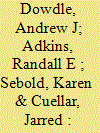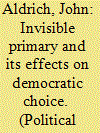| Srl | Item |
| 1 |
ID:
149336


|
|
|
|
|
| Summary/Abstract |
The 2016 Republican presidential nomination challenges arguments about political party insiders’ influence on the outcome. This article argues, first, that party insider influence is conditional on the participation, coalescence, and timing of party stakeholders behind a front-runner during the invisible primary, and second, that party insider influence has probably declined since the 2000 presidential election. Data on endorsements by elite elected officials in open presidential nominations from 1984 to 2016 show that party insiders’ participation and convergence of support behind the front-runner is less extensive than what was found by Cohen, Karol, Noel, and Zaller (2008), though the data sets differ. Party insiders participate and unify more readily when the party coalition is stable and there is a candidate in the race who has demonstrable national support. Party elites remain on the sidelines when the party coalition is divided or when there is uncertainty about the appeal of candidates (Ryan 2011; Whitby 2014). The potency of insider endorsements likely has declined with the rise of social media, the changing campaign finance landscape, and the reemergence of populism in each party.
|
|
|
|
|
|
|
|
|
|
|
|
|
|
|
|
| 2 |
ID:
149333


|
|
|
|
|
| Summary/Abstract |
A number of scholars successfully modeled and predicted presidential nomination outcomes from 1996–2008. However, dramatic changes occurred in subsequent years that would seem to make replicating these results challenging at best. Building on those earlier studies, we utilize a series of OLS models that included measures of preprimary resources and early campaign successes or failures to forecast that Hillary Clinton and Donald Trump would win the Democratic and Republican presidential nominations in 2016. This outcome suggests that some fundamental factors governing nomination outcomes have not changed despite the conventional wisdom.
|
|
|
|
|
|
|
|
|
|
|
|
|
|
|
|
| 3 |
ID:
090230


|
|
|
|
|
| Publication |
2009.
|
| Summary/Abstract |
The current method for selecting presidential nominees by the two major parties went into place mostly in 1972 and certainly by 1976, after Buckely v. Valeo. It was the natural culmination of reform efforts over the history of the republic in that, while prior reforms consistently invoked greater openness and democratic governance as rationales for their adoption, this method actually empowered voters as the central figures in determining who would be nominated (see Aldrich 1987). This fact became fully evident almost at once. The selection via primaries of senator George McGovern in 1972 and governor Jimmy Carter in 1976 as the Democratic presidential nominees arguably not only would not have happened, they would not have even come close to winning nomination without successful appeal to the voting public.
|
|
|
|
|
|
|
|
|
|
|
|
|
|
|
|